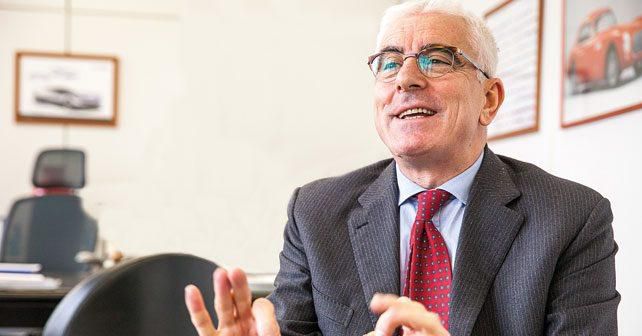
The CEO of Pininfarina says that the sale to Mahindra is a good deal, for more reasons than one…
“It’s good to look at Earth from Space. It’s positive, it helps open your horizons,” says Silvio Angori, the CEO of Pininfarina, as he points towards a reproduction of a photograph taken from the Apollo 11 space shuttle hanging on his office wall. The picture – in memory of the passion that led him to get a degree in physics – is placed next to an image that portrays Armstrong attempting to take the first step on the lunar surface. It’s almost a vague metaphor of the epochal leap that the company in Turin, Italy, made in December 2015 as it joined forces with Tech Mahindra – an engineering unit of Mahindra & Mahindra. “But we will remain a reference of, and for, Italian style,” insists the CEO.
But the owners are no longer Italian?
Finding an investor was inevitable. Some may say that it would’ve been better if the investor were Italian. For us, it was important to have an investor with an industrial background – and one that will be able to devise a long-term strategy. We did not want a financial investor that would use our resources to build its reputation for short-term gain, before selling the asset to others.
How have the last few years been for you?
They have been very complicated. The change of face and mission, however, did not affect our creativity and skills. We have made, and continue to make, iconic and historical car designs – even though the world around us has changed drastically. Around the world, our image is of a company that has made some revolutionary designs. At the same time, one must not forget that historically we have also manufactured automobiles for third parties – and, until 2008, this activity accounted for nearly 90% of our turnover. Everything has been different since our production facility was shut.
A common fate for many design houses?
Yes, and not everyone has made it safely. In Europe, initially, there were six design and production houses – Bertone, Heuliez, Magna, Karmann, Valmet, and us. Of these, Magna is a manufacturing giant – and, for better or worse, continues to be so. Valmet has ‘recycled’ itself as a supplier of parts, but all the others have disappeared.
And what’s the secret to your success?
Among all the other operations our firm deals in, we have managed to save the design and engineering expertise from the financial meltdown. We managed to achieve this because of our stable financial situation. Let’s face it – the automakers in the late 90’s had transferred their business risk onto their suppliers.
What about the future?
Among all the investors, Tech Mahindra offered the maximum potential synergy. With $4.2 billion in sales, it operates in fields that – with the addition of Pininfarina’s know-how – can provide benefits to our customers. Indians are active in information technology, electronics, and data management – all essential qualities for anyone designing a connected car. Tech Mahindra is greatly involved in engineering activities related to energy, aerospace, transport and the auto sector. We are present in some of these verticals, and not in others – so we think we complement each other. Our clients will find this mix a complete solution to their needs.
And what do the employees have to say about the news?
In general, our employees also think that the change is good – because they understand the whole situation, and know how this (the deal) works for us. We have 160 clients – Tech Mahindra has 860! If we manage to sell our services to even 10% of them, it would be an interesting and profitable aspect for all of us. Then, as per the agreement, we will get an additional $20 million capital increase and a further commercial agreement for using the brand’s resources. At closing, the debt will reduce by 60% - which is close to $40 million, rescheduled over ten years and guaranteed by Tech Mahindra. In addition, there will be more investments flowing in for future projects.
In what areas?
In the automotive business, the demand for new mobility planning will increase in the coming time – mostly in terms of connectivity and autonomous driving. The real estate and transportation businesses are also booming. Future smart cities will require the design of ad-hoc integrated systems, which I’m sure will give us enormous opportunities.
ITS HEART AND MIND WILL STILL BE IN ITALY
On December the 14th, Tech Mahindra, with its parent company Mahindra & Mahindra, committed to purchase all of the 24 million shares held by the Pincar (the major stakeholder in Pininfarina). The agreement will be formalized by the summer of 2016. Paolo Pininfarina (below, with the CEO of Tech Mahindra, C P Gurnani) said: “Pininfarina will continue to offer its style and engineering services to companies that recognize our experience. Our heart and head remain in Italy.”


Born in 1961, Silvio Angori graduated in Physics from the University of Sapienza, Rome. He also obtained a Masters in Business Administration from the University of Chicago (USA).
? He began his career in 1989 with Agusta Helicopters, only to make it to the Fiat research centre a year later.
? In 1994, he moved to Arvin Meritor (an automotive components company).
? Working with Pininfarina since 2007, he became the CEO of the company in 2009.
© Riproduzione riservata




















Write your Comment